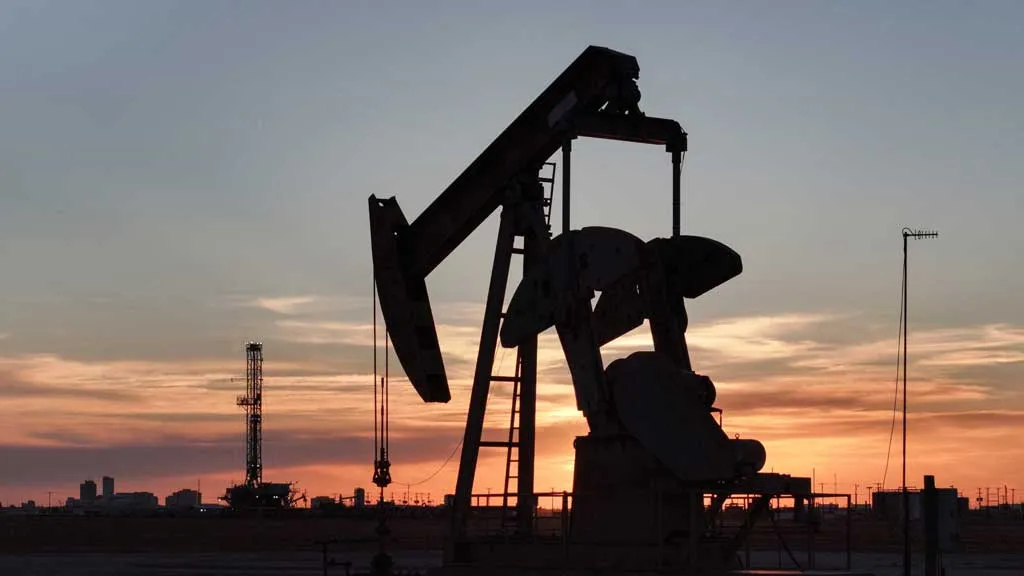The delicate equilibrium of global energy markets was shattered early Friday as news broke of Israeli strikes against targets in Iran, sending oil prices surging by more than 9% and pushing crude to its highest levels in almost five months. This dramatic escalation of tensions in the Middle East has sent a palpable tremor through financial markets worldwide, reigniting deep-seated worries about potential disruptions to vital oil supplies and the specter of a broader regional conflagration.
Brent crude futures, the international benchmark, jumped an alarming $6.29, or 9.07%, to reach $75.65 a barrel by 0315 GMT, having briefly touched an intraday high of $78.50 – a price point not seen since January 27. Similarly, U.S. West Texas Intermediate (WTI) crude roared up by $6.43, or 9.45%, to $74.47 a barrel, after touching $77.62, its loftiest perch since January 21. These were the largest intraday moves for both contracts since 2022, when Russia’s invasion of Ukraine sent shockwaves through energy markets, demonstrating the sheer intensity of the current market reaction.
“This has elevated geopolitical uncertainty significantly and requires the oil market to price in a larger risk premium for any potential supply disruptions,” noted analysts led by Warren Patterson at ING, capturing the sentiment reverberating across trading floors. For investors, governments, and everyday citizens alike, the question now looms large: How will this fresh chapter of an age-old conflict unfold, and what will its true cost be?
The Spark That Ignited the Oil Markets: A Friday Morning Escalation
The immediate catalyst for Friday’s seismic market reaction was Israel’s declaration that it had targeted critical sites within Iran, including nuclear facilities, ballistic missile factories, and military commanders. This was presented by Israel as the commencement of what it warned would be a “prolonged operation” aimed at preventing Tehran from developing an atomic weapon. Such a direct and overt attack on Iranian soil marks a perilous new phase in the long-simmering rivalry between the two regional powers.
Iran’s response was swift and defiant. Supreme Leader Ayatollah Ali Khamenei vowed that Israel would face “harsh punishment” for the attack, which he claimed resulted in the deaths of several military commanders. The rhetoric from Tehran immediately signaled an intent for retaliation, deepening the global anxiety about the potential for a spiraling cycle of violence that could ensnare the entire Middle East.
Oil traders in Singapore, watching the screens with bated breath, acknowledged the gravity of the situation but cautioned against immediate conclusions. “It’s too early to tell but I think the market is worried about shutting off of the Strait of Hormuz,” one trader remarked, highlighting the immediate focus on the region’s most critical energy chokepoint. Saul Kavonic, senior energy analyst at MST Marquee, echoed this sentiment, adding that a material impact on oil supply would necessitate Iranian retaliation directly targeting regional oil infrastructure or, in an “extreme scenario,” the impedance of passage through the Strait of Hormuz, a nightmare scenario that could hinder up to 20 million barrels per day of oil supply.
The Deep Roots of Enmity: Unpacking the Israel-Iran Conflict
The current hostilities are not isolated incidents but rather explosions stemming from decades of escalating animosity and a complex web of geopolitical interests. Once allies under the Shah, relations between Israel and Iran deteriorated sharply after the 1979 Islamic Revolution. The new Iranian regime adopted a staunchly anti-Israel stance, withdrawing recognition of the state and severing all diplomatic and commercial ties, viewing Israel as an illegitimate entity and a colonial outpost.
This ideological opposition rapidly translated into a strategic rivalry played out across the region. Iran has built a sophisticated network of proxy forces and allies, often referred to as the “Axis of Resistance,” designed to project its influence and challenge what it perceives as Israeli and American hegemony. Key among these are:
- Hezbollah in Lebanon: A powerful Shi’ite political party and militant group that Iran has heavily funded and armed since Israel’s 1982 invasion of Lebanon. Hezbollah has fought multiple conflicts with Israel, most notably in 2006, and possesses a significant arsenal of rockets and missiles.
- Hamas and Palestinian Islamic Jihad (PIJ) in Gaza: Iran has provided material support to these Palestinian groups, intensifying the Israeli-Palestinian conflict, which has seen several devastating wars, including those in 2008-2009, 2012, 2014, 2021, and the ongoing conflict since late 2023.
- Houthi rebels in Yemen: The Houthis, a Shi’ite armed movement, have received Iranian support and have recently gained global notoriety for their attacks on shipping in the Red Sea, ostensibly in solidarity with Palestinians.
- Various Shi’ite militias in Iraq and Syria: Iran has cultivated and supported a range of non-state actors in these countries, often operating close to Israeli borders, providing a direct threat and complicating regional security.
Israel, for its part, views Iran as an existential threat, particularly given Tehran’s pursuit of a nuclear program and its leaders’ often inflammatory rhetoric predicting Israel’s demise. In response, Israel has consistently sought international sanctions against Iran and has conducted numerous covert and overt operations aimed at disrupting Iranian nuclear and military capabilities, including suspected assassinations of nuclear scientists and airstrikes against Iranian-allied forces in Syria. This intricate, often shadow war has now burst into the open with direct strikes, raising the stakes to an unprecedented level.
Iran’s Nuclear Ambitions: The Central Flashpoint
At the heart of the Israel-Iran conflict lies Iran’s nuclear program. Israel, along with many Western nations, harbors deep suspicions that Iran is secretly pursuing nuclear weapons capabilities, a claim Tehran vehemently denies, insisting its nuclear activities are purely for peaceful energy and medical purposes.
The landmark 2015 Joint Comprehensive Plan of Action (JCPOA), often referred to as the Iran nuclear deal, was designed to constrain Iran’s nuclear program in exchange for sanctions relief. However, the deal began to unravel when the US unilaterally withdrew from it in 2018. Since then, Iran has progressively rolled back its commitments, increasing its uranium enrichment levels and stockpiles.
The International Atomic Energy Agency (IAEA), the global nuclear watchdog, has repeatedly expressed alarm over Iran’s non-compliance. Just last week, an IAEA report criticized Iran’s “general lack of co-operation” and revealed that Iran possessed enough uranium enriched to 60% purity to potentially make “nine nuclear bombs.” This week, the IAEA’s board of governors formally declared Iran in breach of its non-proliferation obligations for the first time in 20 years, with 19 of 35 member countries, including the US, UK, France, and Germany, voting for the motion. Iran condemned the resolution as “political” and threatened to open a new enrichment facility, further highlighting the impasse.
For Israel, an Iranian nuclear weapon is seen as an existential threat, necessitating a proactive and aggressive stance. Israeli Prime Minister Benjamin Netanyahu has repeatedly stressed that Israel will do whatever it takes to prevent Iran from acquiring nuclear capabilities. The recent strikes, targeting facilities potentially linked to this program, underscore Israel’s determination to act unilaterally if it perceives diplomacy and sanctions as insufficient.
The Strategic Lifeline: Why the Strait of Hormuz Holds the World’s Breath
The immediate fear articulated by oil traders – the “shutting off of the Strait of Hormuz” – is not hyperbole. This narrow sea passage, connecting the Persian Gulf to the open ocean, is arguably the world’s most critical oil chokepoint. At its narrowest point, it is only 21 nautical miles (39 km) wide, with two 2-mile-wide shipping lanes for inbound and outbound traffic.
The numbers are staggering: an average of 20 to 21 million barrels per day (mb/d) of oil transited the Strait of Hormuz in the first ten months of 2023. This accounts for nearly 30% of the world’s seaborne oil trade and roughly 20-25% of total global oil consumption. It is the primary export route for crude oil pumped by major OPEC producers like Saudi Arabia, the UAE, Kuwait, Qatar, Iraq, and Iran itself. Crucially, around 70% of this oil is destined for Asian markets, making East Asian economies particularly vulnerable to any disruption.
Any prolonged blockage or significant disruption to flows through the Strait would have catastrophic consequences for world oil markets, driving prices to unprecedented levels and potentially triggering a global recession. While some countries like Saudi Arabia and the UAE have limited alternative pipeline routes (e.g., Saudi Arabia’s pipeline to the Red Sea, the UAE’s pipeline to the Port of Fujairah, offering about 4.2-6.5 mb/d of crude capacity), these cannot fully compensate for a complete closure of the Strait. Iran, by contrast, relies almost exclusively on its Gulf terminals to export oil, making its own economy highly dependent on the Strait’s openness.
Iran has, in the past, repeatedly threatened to close the Strait of Hormuz in response to perceived aggressions, particularly concerning its nuclear program or sanctions. Its strategic location, bordering Iran and Oman, gives Tehran a powerful, albeit risky, leverage point in any major confrontation. The possibility, however remote, of such a move is precisely why global markets react with such alarm.
Understanding Oil Benchmarks: Brent, WTI, and the Geopolitical Premium
The oil market doesn’t trade on a single price, but rather on various “benchmarks,” each representing a specific crude oil type and region. The two most prominent are:
- Brent Crude: This benchmark originates from oil fields in the North Sea (between the UK and Norway). It is considered the international benchmark for light sweet crude oil and is used to price approximately two-thirds of the world’s internationally traded oil supplies, particularly in Europe, Africa, and the Middle East. Its proximity to sea routes makes transportation relatively efficient.
- West Texas Intermediate (WTI) Crude: Sourced primarily from landlocked oil fields in the United States (Texas, Oklahoma, North Dakota), WTI is also a light sweet crude. It is the preferred measure and pricing model for the U.S. light oil market and relies heavily on pipelines and storage facilities for distribution, notably at Cushing, Oklahoma.
While both are “light” (low density) and “sweet” (low sulfur content), making them easier and cheaper to refine into gasoline, their geographical differences mean they react differently to various factors. Brent is generally more sensitive to global geopolitical events and supply disruptions outside North America, whereas WTI’s pricing is more influenced by domestic US factors like inventory levels and shale production. This explains why Brent tends to be priced higher than WTI and why its price surged more acutely on Friday; the threat is distinctly global, emanating from a critical supply region.
The rapid increase in oil prices also reflects a phenomenon known as the “risk premium.” This is an added component to the price of oil that investors demand to compensate for perceived geopolitical risks. When tensions escalate, traders anticipate potential supply shortages, and they are willing to pay more for immediate delivery or for future contracts to hedge against even higher prices. This speculative buying, driven by fear and uncertainty, pushes prices up further, even before any actual supply disruption occurs.
Echoes of the Past: A History of Oil Shocks and Crisis
The current surge in oil prices is a stark reminder that geopolitical events have, throughout history, been potent catalysts for volatility in energy markets. The past is replete with examples of how conflict can send oil prices spiraling, with devastating economic consequences:
- The 1973 Arab Oil Embargo: During the Yom Kippur War, Arab oil-producing nations imposed an embargo on oil shipments to countries supporting Israel. Oil prices quadrupled within a year, triggering a global energy crisis, severe fuel shortages, and widespread economic recession in the West. It fundamentally reshaped energy policies and highlighted the world’s dependence on Middle Eastern oil.
- The 1979 Iranian Revolution: The overthrow of the Shah and the ensuing political instability in Iran led to significant disruptions in oil production, causing a second major oil shock. Prices doubled, contributing to inflation and economic slowdowns globally.
- The Gulf Wars (1990-91 and 2003): Iraq’s invasion of Kuwait and the subsequent military interventions sent oil prices soaring due to fears of supply disruption from the region.
- The Russia-Ukraine War (2022 onwards): The invasion and subsequent sanctions on Russian energy exports caused a sharp spike in oil and gas prices, demonstrating how regional conflicts, even outside the Middle East, can have profound global energy implications.
These historical precedents underscore that the current situation is not just a passing market fluctuation but a serious threat with the potential to inflict severe economic pain on a global scale.
The Global Economic Tremor: High Oil Prices and the Ripple Effect
When oil prices soar, the economic tremors are felt far and wide, impacting everything from the cost of your morning commute to the price of goods on supermarket shelves. This is because crude oil is not just a fuel; it’s a fundamental input for countless industries and a major component of transportation costs.
- Inflationary Pressure: Higher oil prices directly contribute to inflation. This is evident as increased fuel costs directly affect transportation, manufacturing, and agricultural sectors. Businesses face higher operational costs, which they often pass on to consumers in the form of higher prices for goods and services. The International Monetary Fund (IMF) and the Federal Reserve have frequently highlighted how significant oil price increases can add percentage points to inflation and trim economic growth.
- Consumer Spending: As fuel prices rise, households have less disposable income for other goods and services, leading to a slowdown in consumer spending, which is a major driver of economic growth. This is particularly felt in countries heavily reliant on oil imports.
- Transportation Sector: Airlines, shipping companies, logistics firms, and public transport operators face dramatically increased fuel bills. This either forces them to raise fares/freight costs (further fueling inflation) or eat into their profit margins. For instance, the cost of flying or shipping goods across continents becomes significantly more expensive.
- Manufacturing and Agriculture: Oil derivatives are crucial in manufacturing processes (plastics, chemicals, fertilizers). Higher oil prices lead to increased production costs for a vast array of products, from agricultural produce (due to higher fertilizer and transport costs) to consumer electronics.
- Energy Transition Paradox: Ironically, consistently high oil prices can paradoxically accelerate the transition to renewable energy sources by making them more economically competitive. However, in the short term, they create significant economic headwinds.
In sum, sustained high oil prices act as a tax on the global economy, slowing growth, exacerbating inflation, and disproportionately affecting lower-income households and developing nations that are net oil importers.
Diplomatic Dilemmas and Dangerous Declarations: International Reactions
The immediate aftermath of the Israeli strikes has been marked by a flurry of reactions, each carefully weighted for its potential impact on an already volatile situation.
- Iran’s Stance: Supreme Leader Ayatollah Ali Khamenei’s pronouncement of “harsh punishment” signals Iran’s intent to retaliate, though the form and timing remain uncertain. Tehran’s long-standing strategy has often involved asymmetric responses and leveraging its network of proxies, making a direct military confrontation with Israel or the US less likely, but not impossible. The challenge for Iran will be to devise a response that demonstrates resolve without triggering a full-scale war that could devastate its economy and infrastructure.
- Israel’s Position: The Israeli government has framed its actions as a necessary preemptive measure to safeguard its national security. Prime Minister Netanyahu’s statement about a “prolonged operation to prevent Tehran from building an atomic weapon” indicates a strategic shift towards more aggressive action against Iran’s nuclear capabilities. This signals Israel’s resolve, regardless of international pressure, to neutralize what it perceives as an existential threat.
- The United States’ Tightrope Walk: The US finds itself in a precarious position, attempting to balance its unwavering support for Israel with a desire to prevent a wider regional conflict. US Secretary of State Marco Rubio’s swift declaration that Israel’s strikes were a “unilateral action” and that Washington was “not involved” aimed to create diplomatic distance. However, he simultaneously urged Tehran “not to target U.S. interests or personnel in the region,” implicitly warning against retaliation that would draw the US into the conflict. Reports from CBS News prior to the strikes indicated US officials were aware of Israel’s readiness to act, and that the US might provide “supporting roles with refueling and intelligence,” but not “lead” or “help bomb” Iranian sites with American munitions. This delicate dance highlights the complexities of US foreign policy in a region where its allies and adversaries are deeply intertwined. President Trump, whose administration has been engaged in a nuanced relationship with Netanyahu and even direct negotiations with Iran, faces immense pressure to safeguard American interests while navigating a highly unpredictable scenario. As Priyanka Sachdeva, senior market analyst at Phillip Nova, pointed out, “Although Trump has shown reluctance to participate, U.S. involvement could further raise concerns.”
The international community, particularly European powers, will likely intensify diplomatic efforts to de-escalate the situation, but the current state of US-Iran and Israel-Iran relations leaves little room for easy resolution. The recent IAEA resolution against Iran only adds to the diplomatic complexities.
Investor Flight to Safety: Beyond Oil, the Broader Market Impact
The surge in oil prices is merely one symptom of a broader market panic. Global financial markets, inherently sensitive to geopolitical instability, reacted predictably with a classic “flight to safety” maneuver.
- Stocks Dive: In early Asian trade, equities plummeted, led by a sharp selloff in U.S. futures. The Dow, S&P 500, and Nasdaq, which had closed slightly higher on Thursday, are expected to open significantly lower as investors shed riskier assets. Companies across various sectors, from manufacturing to airlines, will face immediate pressure from rising energy costs, prompting investors to pull out.
- Safe Havens Soar: Conversely, assets traditionally perceived as safe havens during times of crisis saw immediate gains. Gold, a timeless store of value, surged as investors sought refuge from market volatility and inflation fears. The Swiss franc, known for its stability and the neutrality of Switzerland, also strengthened as capital flowed into its perceived security. Government bonds from stable economies, particularly US Treasuries, are also likely to see increased demand, pushing their yields down. This shift reflects a profound loss of investor confidence and a desperate search for security amidst the uncertainty.
The interconnectedness of global markets means that a conflict in the Middle East has immediate and far-reaching consequences, impacting portfolios from New York to Tokyo.
The Human Dimension: Lives Intertwined with Geopolitics and Energy
While analysts dissect market movements and geopolitical strategies, it is crucial to remember the profound human cost. Beyond the financial figures, conflict, and the economic instability it breeds, directly impact millions of lives.
For the people living in the Middle East, the escalating tensions mean heightened fear, potential displacement, and further disruption to daily life. The human suffering caused by past conflicts in the region is immeasurable, and any further escalation threatens to add to this tragic toll. Civilian populations bear the brunt of violence, economic hardship, and the breakdown of essential services.
Globally, sustained high oil prices hit the pockets of everyday people. Increased transport costs mean higher prices for food and other necessities, squeezing household budgets already strained by inflationary pressures. Businesses face tough decisions, potentially leading to job losses or reduced investment. The ripple effect of a geopolitical crisis in one part of the world underscores the interconnectedness of human well-being, energy security, and global stability.
Conclusion: A Future Shrouded in Uncertainty
Friday’s Israeli strikes on Iran have flung open a new, perilous chapter in the Middle East’s tumultuous history, sending immediate and stark warnings across global energy markets. The surge in oil prices is not merely a number on a trading screen; it is a tangible reflection of the profound uncertainty that now grips the world.
The coming days and weeks will be critical. How Iran chooses to retaliate, the extent of international involvement, and the trajectory of diplomatic efforts will determine whether this moment marks a dangerous, fleeting flare-up or the precipice of a much larger, more devastating conflict. The world watches, hoping for de-escalation, but preparing for the potential seismic shifts that could reshape not only the geopolitical map but also the very foundations of the global economy and the lives of countless individuals. The intertwined fate of oil, conflict, and human prosperity has never been more evident.
Ready to take your career to the next level? Join our dynamic courses: ACCA, HESI A2, ATI TEAS 7 , HESI EXIT , NCLEX – RN and NCLEX – PN, Financial Literacy!🌟 Dive into a world of opportunities and empower yourself for success. Explore more at Serrari Ed and start your exciting journey today! ✨
photo source: Google
By: Montel Kamau
Serrari Financial Analyst
13th June, 2025
Article, Financial and News Disclaimer
The Value of a Financial Advisor
While this article offers valuable insights, it is essential to recognize that personal finance can be highly complex and unique to each individual. A financial advisor provides professional expertise and personalized guidance to help you make well-informed decisions tailored to your specific circumstances and goals.
Beyond offering knowledge, a financial advisor serves as a trusted partner to help you stay disciplined, avoid common pitfalls, and remain focused on your long-term objectives. Their perspective and experience can complement your own efforts, enhancing your financial well-being and ensuring a more confident approach to managing your finances.
Disclaimer: This article is for informational purposes only and does not constitute financial advice. Readers are encouraged to consult a licensed financial advisor to obtain guidance specific to their financial situation.
Article and News Disclaimer
The information provided on www.serrarigroup.com is for general informational purposes only. While we strive to keep the information up to date and accurate, we make no representations or warranties of any kind, express or implied, about the completeness, accuracy, reliability, suitability, or availability with respect to the website or the information, products, services, or related graphics contained on the website for any purpose. Any reliance you place on such information is therefore strictly at your own risk.
www.serrarigroup.com is not responsible for any errors or omissions, or for the results obtained from the use of this information. All information on the website is provided on an as-is basis, with no guarantee of completeness, accuracy, timeliness, or of the results obtained from the use of this information, and without warranty of any kind, express or implied, including but not limited to warranties of performance, merchantability, and fitness for a particular purpose.
In no event will www.serrarigroup.com be liable to you or anyone else for any decision made or action taken in reliance on the information provided on the website or for any consequential, special, or similar damages, even if advised of the possibility of such damages.
The articles, news, and information presented on www.serrarigroup.com reflect the opinions of the respective authors and contributors and do not necessarily represent the views of the website or its management. Any views or opinions expressed are solely those of the individual authors and do not represent the website's views or opinions as a whole.
The content on www.serrarigroup.com may include links to external websites, which are provided for convenience and informational purposes only. We have no control over the nature, content, and availability of those sites. The inclusion of any links does not necessarily imply a recommendation or endorsement of the views expressed within them.
Every effort is made to keep the website up and running smoothly. However, www.serrarigroup.com takes no responsibility for, and will not be liable for, the website being temporarily unavailable due to technical issues beyond our control.
Please note that laws, regulations, and information can change rapidly, and we advise you to conduct further research and seek professional advice when necessary.
By using www.serrarigroup.com, you agree to this disclaimer and its terms. If you do not agree with this disclaimer, please do not use the website.
www.serrarigroup.com, reserves the right to update, modify, or remove any part of this disclaimer without prior notice. It is your responsibility to review this disclaimer periodically for changes.
Serrari Group 2025












